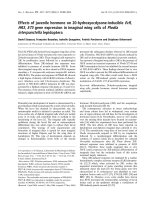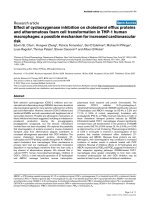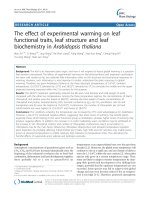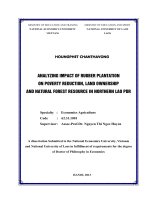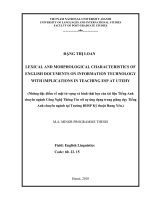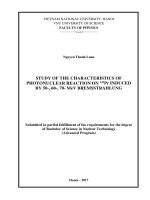Characteristics of soil acidification of haplic acrisols on ancient alluvial deposits under intensive cassava cultiva tion in chau thanh district, tay ninh province VJES
Bạn đang xem bản rút gọn của tài liệu. Xem và tải ngay bản đầy đủ của tài liệu tại đây (523.57 KB, 9 trang )
Vietnam Journal of Earth Sciences 39(2), 130-138, DOI: 10.15625/0866-7187/39/2/9447
Vietnam Academy of Science and Technology
(VAST)
Vietnam Journal of Earth Sciences
/>
Characteristics of soil acidification of haplic Acrisols on
ancient alluvial deposits under intensive cassava cultivation in Chau Thanh district, Tay Ninh province
Nguyen Tho*1, Nguyen Thi Hoa2
1
Ho Chi Minh City Institute of Resources Geography, 01 Mac Dinh Chi, District 1, Ho Chi Minh City
2
Saigon University, 273 An Duong Vuong, Disrict 5, Ho Chi Minh City
Received 21 January 2017. Accepted 21 March 2017
ABSTRACT
This paper clarified the characteristics of soil acidification of haplic Acrisols on ancient alluvial deposit under intensive cassava cultivation in Chau Thanh district, Tay Ninh province, Southeastern Vietnam. Soils were sampled at
3 intervals (0-20, 20-40, 40-60 cm in depth) in 12 sites of intensive cassava cultivation and geochemical parameters
related to soil acidity were analysed. The haplic Acrisols under intensive cassava cultivation showed quite high levels
of active and exchange acidity (pHH2O 4.40±0.11, pHKCl 3.98±0.07). The hydrolytic acidity and Al saturation level
were also high (respectively 4.52±0.37 meq/100g and 57.64±6.41%) while the exchange alkali and alkaline earth
cations were very low (Ca2+ 0.76±0.25 meq/100g, Mg2+ 0.88±0.85 meq/100g, K+ 0.16±0.06 meq/100g in the top layer). This exhibited a limit for mineral nutrients and risk of Al toxicity to cassava plants. If the area for intensive cassava cultivation is expanded and the high-yield cassava varieties are applied, the risk of soil acidification will be expected to be highly serious. It is needed to clarify the processes involved and to establish measures to reduce soil
acidification and stabilize cassava production in the study area and Tay Ninh province.
Keywords: soil acidification, nutrient, haplic Acrisols, Tay Ninh, cassava.
©2017 Vietnam Academy of Science and Technology
1. Introduction1
Soil acidification as a result of intensive
cassava cultivation in upland areas is an issue
of global concern. Intensive cassava cultivation has been proved to cause the depletion or
nutrient imbalance in soils in Africa (Kenya,
Uganda, Cameroon) and Southeast Asia
(Thailand, Cambodia) (Araki, Sarr, 2013;
CIAT, 2007; Francis et al., 2013; Noble et al.,
2004; Sarr et al., 2013). The major causes of
*
Corresponding author, Email:
130
this are surface erosion and run-off, leaching,
and harvest of biomass (Howeler, 1996;
CIAT, 2007). Nutrients (particularly Ca and
N) removed from soils are highly intensive if
stems and leaves of cassava are also harvested
(Howeler, 2001). The final consequence is the
mass leaching of bases and accumulation of
acidic components into the soils, leading to an
overall soil acidification.
In Vietnam, cassava has largely been consumed in the domestic market and is one of
the main crops for export (Pham Van Bien et
al., 2002; Le Huy Ham et al., 2016). It pro-
Nguyen Tho and Nguyen Thi Hoa/Vietnam Journal of Earth Sciences 39 (2017)
vides low yield in general, partly due to the
fact that it is often planted on slope soils,
which are heavily eroded and nutrientdepleted (Howeler, Phien, 2000). Nutrient
imbalance and nutrient loss in upland soils
under intensive cassava cultivation areas have
been reported, for example, Nguyen Tu Siem,
Thai Phien (1993) and Sat, Deturck (1998).
This issue is very serious in the Southeast of
Vietnam, even after 2 years of cultivation
(Nguyen Tu Siem, Thai Phien, 1993).
Tay Ninh province is located in the Southeast of Vietnam and covers an area of
4.035,45 km2, in which Acrisols accounts for
84,13%. This soil group in Tay Ninh composes of three soil units, consisting of Haplic Acrisols (230,323 ha), Stagni-Plinthic Acrisols
(50,526 ha) and Gleyic Acrisols (49,184 ha)
(Sub-NIAPP, 2004). Due to the natural conditions and market demand, the area for cassava
cultivation has been on the increase in Tay
Ninh province, particularly in Tan Bien, Tan
Chau, Chau Thanh and Duong Minh Chau
districts. According to the provincial planning
for agriculture, the area for cassava cultivation
in 2020 will rank 4th and occupy 29,000 ha,
after sugarcane (30,000 ha), rubber (87,000
ha), and rice (125,000 ha) (Tay Ninh Provincial People’s Committee, 2012).
The haplic Acrisols on ancient alluvial deposit in Tay Ninh province are light-textured,
highly eroded, and acidic soils. The rapid development of intensive cassava production
might increase the risk of acidification of these soils. Up to present, there has been no
study dealing with factors and processes relating to soil acidification due to cassava cultivation in Tay Ninh province. To build up
grounds for the deeper understanding on soil
acidification, this paper aims to examine the
characteristics of soil acidification of haplic
Acrisols on ancient alluvial deposited under
cassava cultivation areas in Chau Thanh
district.
2. Materials and methods
2.1. Study area
Chau Thanh district (571.25km2) is located
at the South-West border of Tay Ninh province, sharing the 48 km borderline with Svay
Rieng province of Cambodia. There is a
source of all-year-round freshwater supply,
making the area highly favorable for agricultural development. Haplic Acrisols in this area
mainly distribute in mounds or in elevated
foot slopes.
Cassava is cultivated on a wide range of
topography of the district (Figure 1a). Land
areas for cultivating cassava was previously
used to grow other crops, such as rice, tobacco, cashew, or cassava intercropped with other
vegetables. This conversion is taken place due
to a higher economic return of cassava in
comparison to the former crops. Following
harvest, farmers often shred the stems and
bury it with the leaves into the soil surface
layers (Figure 1b).
(a)
(b)
Figure 1. Intensive cassava cultivation in Chau Thanh district
131
Vietnam Journal of Earth Sciences 39(2), 130-138
2.2. Soil sampling and analysis
Soils were sampled at 12 sites (Figure 2) in
August 2015 based on the soil map of Tay
Ninh province, scale 1:100,000) (Sub-NIAPP,
2004). At each sampling site, samples were
collected at 3 depth intervals (0-20 cm, 20-40
cm, and 40-60 cm in depth) after removing the
topsoils generated by raised beds in 3 profiles
within an area of about 400 m2. Samples of the
same depths in these 3 profiles were mixed to
form a composite sample for analysis. In total,
there were 36 soil samples to be analysed.
Figure 2. Chau Thanh district and the sampling sites
In the laboratory, samples were air-dried,
ground and passed through a 2 mm sieve, then
were analysed at Ho Chi Minh City Institute of
Resources Geography and Ho Chi Minh City
University of Science. The parameters, methods, and calculations are as follows (1) pHH2O:
by pH-meter after extracted with distilled water
(1/2.5); (2) pHKCl: by pH-meter after extracted
with KCl 1N (1/5); (3) exchange acidity: extracted with KCl 1N, titrate the filtered solution
by NaOH 0.02N with phenolphthalein as color
132
indicator to light pink color; (4) exchange H+
and Al3+: titrate the filtered solution after extracted with KCl 1N with NaOH 0.02N (phenolphthalein as indicator) to light pink color
(after precipitating Al3+ by NaF 3,5%) to calculate exchange H+, then exchange Al3+ is calculated by subtracting exchange H+ from the exchange acidity; (5) hydrolytic acidity: extracted
with CH3COONa 1M (pH 8) and titrated with
NaOH 0.1N with phenolphthalein as color indicator to light pink color; (6) Exchange alkali
Nguyen Tho and Nguyen Thi Hoa/Vietnam Journal of Earth Sciences 39 (2017)
and alkaline earth cations (Ca2+, Mg2+, K+):
extracted with CH3COONH4 1N (pH 7) and
measured by Atomic Absorption Spectrometry;
(7) effective CEC (eCEC) = sum of exchange
base cations + exchange acidity; (8) Base saturation = (sum of exchange base cations ×
100)/eCEC; (9) Al saturation = (exchange Al3+
× 100)/eCEC; and (10) ΔpH = pHKCl - pHH2O
(Mekaru, Uehara, 1972; Rowell, 1994; Soils
and Fertilizers Research Institute 1998).
2.3. Statistical analysis
Descriptive statistics, t-test (dependent
samples) and Repeated Measured ANOVA
were applied. The independent variable is
“depth” with 3 levels (0-20cm, 20-40cm, 4060cm). Dependent variables are geochemical
Table 1. The geochemical parameters
study area
Parameter
pHH2O
pHKCl
ΔpH
Exchange acidity
Exchange H+
Exchange Al3+
Exchange Ca2+
Exchange Mg2+
Exchange K+
Sum of exchange base cations
eCEC
Base saturation (BS)
Al in exchange acidity
Al saturation
Hydrolytic acidity
3. Results
The haplic Acrisols in the study area were
characterized by low pH, ΔpH<0, elevated
exchange acidity and Al3+, and low eCEC
(Table 1). While pHH2O showed little variations with depths, pHKCl at 40-60 cm was significantly lower (p<0.05) in comparison to the
topsoil (Figure 3), being similar to the trend of
exchange acidity, exchange Al3+ and sum of
exchange base cations.
related to soil acidity of Haplic Acrisols on ancient alluvial deposit in the
Unit
meq/100g
meq/100g
meq/100g
meq/100g
meq/100g
meq/100g
meq/100g
meq/100g
%
%
%
meq/100g
Mean
4.40
3.98
-0.42
1.7
0.08
1.63
0.65
0.58
0.14
1.36
3.07
39.55
95.22
57.64
4.52
Figure 3. Variations of pHH2O, pHKCl, and ΔpH with
depths
133
parameters. A Pearson correlation matrix was
calculated to examine the correlated levels
among geochemical parameters. The 95% confidence interval of the dependent variables are
set as Mean ± 1.96*SE (standard error). All of
the statistical tests are performed on the Statistica package, version 7.0 (StatSoft, Inc., 2001).
Minimum
3.97
3.68
-1.13
0.68
0.05
0.63
0.13
0.02
0.05
0.23
1.54
13.48
90.82
11.09
2.38
Maximum
5.24
4.64
-0.05
3.33
0.09
3.24
1.7
5.11
0.61
6.66
7.54
88.24
97.81
82.21
6.58
1.96*SE
0.11
0.07
0.08
0.21
0.01
0.2
0.12
0.34
0.04
0.44
0.4
6.69
0.51
6.41
0.37
The mean pHH2O was 4.40±0.11, being
higher than pHKCl (mean 3.98±0.07) for all
depth intervals (p<0.001). On average, ΔpH
was -0.42±0.08 pH unit (Figure 3). The relationship between pHH2O and ΔpH was negative, by which soils reached to the point of
zero charge when ΔpH = 0, corresponding to a
pHH2O of 3.96 (Figure 4). The exchange acidity and Al3+ tend to increase with depths, while
the sum of exchange base cations showed an
opposite trend (Figure 5).
Vietnam Journal of Earth Sciences 39(2), 130-138
Figure 4. Relationship between pHH2O and ΔpH
The hydrolytic acidity was high, ranging
from 2.38-6.58 meq/100g with an overall mean
of 4.52±0.37 meq/100g (Table 1). The hydrolytic acidity slightly varied with depth (Figure
6a) and positively correlated with exchange
acidity (Figure 6b). On average, values of hydrolytic acidity are 2.82±0.28 meq/100g higher
than that of exchange acidity.
Figure 5. Mean±1.96SE of exchange acidity, exchange
Al3+ and sum of exchange base cations of each soil layer
Soil base saturation and mineral nutrients
for cassava (alkali and alkaline earth cations)
were very poor (Table 1). In the top layer,
contents of exchange Ca2+, Mg2+ and K+ were
very low, 0.76±0.25 meq/100g, 0.88±0.85
meq/100g and 0.16±0.06 meq/100g, respectively. Ca2+ and Mg2+ concentrations tend to
reduce with depth (Figure 7).
Figure 6. Mean±1.96SE of exchange acidity and hydrolytic acidity of each soil layer and relationship between exchange acidity and hydrolytic acidity
←Figure 7. Mean±1.96SE of alkali and alkaline earth
cations of each soil layer
4. Discussion
4.1. Active and exchange acidity
According to the classification of soil acidity based on pHH2O (Rengel, 2005), haplic Acrisols in the study area are categorized from
moderately acidic (pHH2O 4.5-5.5) to very
acidic (pHH2O 3.5-4.5), similar to Acrisols in
134
Nguyen Tho and Nguyen Thi Hoa/Vietnam Journal of Earth Sciences 39 (2017)
Tay Ninh province (Sub-NIAPP, 2004; Le
Cong Nong, 2010).
ΔpH<0 (Figure 3) indicated that the exchange surface of soil particles (mostly from
organic matter and clay minerals) contained a
net negative charge, leading to a tendency to
adsorb cations from the soil solution. According to Zołotajkin et al. (2011), ΔpH is dependent on the amount of soil organic matter.
When pHH2O dropped to values lower than
3.96 (soils having ΔpH> 0), an inverse trend
can be expected (Figure 4).
Over the whole profile, pHH2O and pHKCl
were linearly and positively correlated
(p<0.001) (Figure 8a). This correlation was
quite strong in the top layer (R2=0.556,
p<0.01) (Figure 8b) but became weaker at
deeper layers (Figure 8c, 8d), probably due to
the accumulation of Al3+ on the exchange surface of soil particles (Figure 5).
Figure 8. Relationship between pHH2O and pHKCl over the whole soil profile (8a), the 0-20 cm layer (8b), the 20-40
cm layer (8c), and the 40-60 cm layer (8d)
Exchange Al3+ accounted for the majority
of exchange acidity (95.22±0.51%). This is
due to the elevated Al content in Acrisols on
ancient alluvial deposit, which was mostly in
soluble forms at soil pHH2O<5 (Rengel, 2005).
When extracted with KCl, several forms of Al
were released into the soil solution, including
Al(OH)3 (amorphous or precipitated),
dispersed alum inosilicates, networks of
135
hydroxy-Al (AlOH2+, Al(OH)2+) or Al-organic
matter complexes (Rengel, 2005). Al saturation was quite high in the soils
(57.64±6.41%).
The pHH2O and pHKCl of haplic Acrisols in
the study area (Table 1) varied in a large
range in comparison to those of the similar
soil in Don Thuan commune, Trang Bang district, Tay Ninh province (respectively 4.57-
Vietnam Journal of Earth Sciences 39(2), 130-138
4.90 and 3.98-4.18) (Le Cong Nong, 2010).
Exchange acidity of haplic Acrisols in the
study area ranged from 0.68-3.33 meq/100g
(1.70±0.21 meq/100g), being significantly
higher in comparison to Alfisols in Bihar and
West Bengal of India (0.07-0.43 meq/100g)
(Dolui, Mehta, 2001) and Acrisols (Rhodic
Acrisols, Haplic Acrisols) in the coast of
Ghana (≤0.43 meq/100g) (Dowuona et al.,
2012).
The 40-60 cm soil layer was not affected
by root metabolism and land preparation because cassava roots reached to a shallow
depth. The lower pHKCl at 40-60 cm layer as
compared to that of the topsoil inferred that
human impacts on the soil surface may not be
a main driver for soil acidification in the study
area.
study area were higher than those of the similar soil in Don Thuan commune, Trang Bang
district, TayNinh province (respectively 0.150.55 meq/100g and 0.12-0.23 meq/100g) (Le
Cong Nong 2010). The eCEC values was
low (3.07±0.40 meq/100g), in which
exchange Al3+ accounted for the majority
(57.64±6.41%). Base saturation varied in a
large range (13.48-88.24%) with a mean of
39.55±6.69% and has the tendency to decline
with depth (p>0.05) (Figure 9), in accordance
with that of exchange Al3+ and exchange
acidity (Figure 5).
4.2. Hydrolytic acidity
In haplic Acrisols in the study area, the
hydrolytic acidity was higher and positively
correlated with exchange acidity (Figure 6).
The difference between these two kinds of
acidity depends on the clay ratio and total Al
content in the soils (Soils and Fertilizers Research Institute, 1998).
Hydrolytic acidity of Acrisols in the study
area was much higher than that of haplic Luvisol in Slovakia (1.17 meq/100g) (Šimanský,
2011), haplic Cambisol in Rzeszów of Poland
(≤2meq/100g) (Gasior, Puchalski, 2010), Alfisols in Bihar and West Bengal of India
(0.96-3.65 meq/100g) (Dolui, Mehta, 2001)
and other soils (Vertisols, Alfisols and Ultisols) in East Kalimantan of Indonesia
(1.56±0.37 meq/100g) (Supriyo et al., 1992).
This pattern showed a high risk of acidification of haplic Acrisols under intensive casava
cultivation in the study area.
4.3. Alkali and alkaline earth cations, eCEC
and base saturation
The basic cations in soils under research
were very low (Table 1). Exchange Ca2+ and
Mg2+ in the topsoils of haplic Acrisols in the
136
Figure 9. Depth variations of eCEC and BS
4.4. Effects of soil acidity to cassava yield in
the study area
The pHH2O of haplic Acrisols in the study
area was lower in comparison to the optimal
pH range for cassava (pHH2O 5-5.5) (Araki,
Sarr, 2013). Limited contents of basic cations
(Figure 7) is one of the major factors to reduce the cassava yield as demand for mineral
nutrition of cassava, particularly K, is large
(Suyamto, 1998; Juo, Franzluebbers, 2003;
CIAT, 2007; Sanginga, Woomer, 2009).
Al saturation levels were as high as
57.64%. Although cassava can grow in soils
with a Al saturation range from 75-80%
(CIAT, 1979, 2007), cassava yield reaches to
only 90% of the maxima when Al saturation
level exceeds 40% (Kamprath, 1980). Results
demonstrated that the current soil acidity has,
at least in part, posed negative impacts to the
Nguyen Tho and Nguyen Thi Hoa/Vietnam Journal of Earth Sciences 39 (2017)
cassava yield in the study area. This assumption has been confirmed via discussion with
local agricultural officials and farmers during
field research.
5. Conclusions
The haplic Acrisols on ancient alluvial deposit under intensive cassava cultivation in the
study area were acidic. Al saturation level was
high whereas the exchange alkali and alkaline
earth cations (Ca, Mg, K) were very low. This
was one of the major factors to limit cassava
growth and yield. If the cassava cultivation is
expanded and the high-yield cassava varieties
are applied, the acidification effect would be
expected to be more serious. Studying the factors and processes involved and establishing
measures are urgent to mitigate soil acidification in the study area.
Acknowledgements
We would like to thank the comments and
suggestions from anonymous reviewers for
improving the manuscript. This research is
done with financial support from the Vietnam
Academy of Science and Technology
(VAST). The authors also wish to thank staffs
of Ho Chi Minh City Institute of Resources
Geography for their support in fieldwork, Ho
Chi Minh City University of Science for lab
analysis.
References
Araki S., Sarr P.S., 2013. The Effect of Cassava Cultivation on Soil Acidification. Center for African Area
Studies, Kyoto University, Japan. A Report on Cassava Science day, IITA Cameroon February 18,
32-36.
CIAT, 1979. Annual Report for 1978.CIAT, cassava
programme, Cali, Colombia, pp.A76-84. In: Hillocks R.J., Thresh J.M., Bellotti A.C. (Eds.), Cassava: Biology, Production, and Utilization. CABI Publishing, USA, ISBN 0-85199-524-1.
CIAT, 2007. Cassava Research and Development in
Asia: Exploring New Opportunities for an Ancient
Crop. Proceedings of the seven Regional Workshop
137
in Bangkok, Thailand, Oct 28-Nov 1, 2002. Centro
Internacional de Agricultura Tropical, pp.668.
Dolui A.K., Mehta S., 2001. Forms of acidity and lime
requirement of some Alfisols.Agropedology 11,
71-77.
Dowuona G.N.N., Atwere P., Dubbin W., Nude P.M.,
Mutala B.E., Nartey E.K., Heck R.J., 2012. Characteristics of termite mounds and associated acrisols in
the coastal savanna zone of Ghana and impact
on hydraulic conductivity. Natural Science 4(7),
423-437.
Francis N.A., Constant A.M.F., Ijang T.P., Atanga N.S.,
Clarisse M.M.Y., Delphine M-L., Simon N.T., 2013.
Effects of Cassava Cultivation on Soil Quality Indicators in the Humid Forest Zone of Cameroon.
Greener Journal of Agricultural Sciences 3(6),
451-457.
Gasior J., Puchalski C., 2010. Effects of potassium on
the dynamics of chemical elements in brown soil reconstructed profile. Short Communication.Polish
Journal of Environmental Studies 20(3), 789-794.
Howeler R.H., 1996. Mineral nutrition of cassava. In:
Craswell, E.T., C.J. Asher and J.N. O’Sullivan
(Eds.), Mineral nutrient disorder of root crops in the
Pacific. Proceedings of workshop, Nuku’alofa,
Kingdom of Tonga, 17-20 April 1995. ACIAR Proceedings 65, 110-116.
Howeler, R.H. and Phien, T., 2000. Integrated nutrient
management for more sustainable cassava production in Vietnam. Proceedings of the Vietnamese
Cassava Workshop on Progress in Cassava Research
and Extension in Vietnam, 16-18 March 1999, Ho
Chi Minh city, Vietnam, 12-54.
Howeler RH., 2001. Nutrient Inputs and Losses in Cassava-based Cropping Systems-Examples from Vietnam and Thailand. International Workshop on Nutrient Balances for Sustainable Agricultural Production and Natural Resource Management in Southeast
Asia. Bangkok, Thailand, 20-22.
Juo A.S.R., Franzluebbers K., 2003. Tropical Soils:
Properties and Management for Sustainable Agriculture. Oxford University Press, UK, ISBN-10: 0-19511598-8, pp.304.
Kamprath E., 1980. Soil acidity in well-drained soils of
the tropics. In: Juo A.S.R., Franzluebbers K. (Eds.),
Vietnam Journal of Earth Sciences 39(2), 130-138
Tropical Soils: Properties and Management for Sustainable Agriculture, Oxford University Press, New
York, USA, ISBN: 0-19-511598-8, pp.283.
Le Cong Nong, 2010. Study and assess the current conditions, build up the pedological map and provide
solutions to reclaim soils in the Seedling Production
Facility of Trang Bang -Tay Ninh. Research Institute for oil and oil plants.
Le Huy Ham, Hoang Kim, Nguyen Thi Truc Mai,
Nguyen Bach Mai and Reinhardt Howeler, 2016.
The cassava revolution in Vietnam. World Congress
on root and tuber crops. Nanning Guangxi, China
18-22 Jan 2016.
Mekaru T., Uehara G., 1972. Anion Adsorption in Ferruginous Tropical Soils.Soil Science Society of
America Journal 36(2), 296-300.
Nguyen Tu Siem, Thai Phien, 1993. Effect of cultivation
for soil erosion control and fertilization to soil conservation and crop yields on sloping land. Highlight
of research results on science and technology of agriculture. In: Howeler R.H, Phien T. (Eds.), Integrated nutrient management for more sustainable
cassava
production
in
Vietnam.
/>_Integrated_Nutrient_Management.pdf.
Noble A., Ruaysoongnern S., Sukchan S., Berthelsen S.,
2004. Role of soil resource data in assessing soil
acidification risk: an example from Northeast Thailand. In: Eswaran H., Vijarnsorn P., Vearasilp T.,
Padmanabhan E. (Eds.), Innovative techniques in
soil survey: developing the foundation for a new
generation of soil resource inventories and their utilization. Proceedings of a conference, Cha-am, Thailand, 21-26 March 2004, 333-340.
Pham Van Bien, Hoang Kim, Tran Ngoc Ngoan,
Howeler, RH., and Wang, J.J., 2002. New developments in the cassava sector of Vietnam. www.ciat.
cgiar.org/asia_cassava/.
Rengel Z., 2005. Handbook of Soil acidity. Marcel Dekker, Inc, New York, ISBN 0-8247-0890-3, pp.511.
Rowell D.L., 1994. Soil Science: Methods and Applications. Department of Soil Science, University of
Reading, Pearson Education, Prentice Hall, Harlow,
UK, ISBN 0-582-08784-8, pp.345.
138
Sanginga N., Woomer P.L., 2009. Integrated Soil fertility management in Africa: Principles, Practices and
Developmental Process. Tropical Soil Biology and
Fertility Institute of the International Centre for
Tropical Agriculture (TSBF-CIAT), ISBN 978-929059-261-7, pp.263.
Sarr P.S., Araki S., Njukwe E., 2013. Sequential cultivation of cassava varieties in eastern Cameroon: effects on production and soil status. A Report on Cassava Science Day: Cassava performance under different soil management, IITA, Cameroon, Feb. 18,
2013, pp.4-5.
Sat C.D., Deturck P., 1998. Cassava soils and nutrient
management in South Vietnam. In Howeler R.H.
(Eds.), Cassava breeding, agronomy and farmer participatory research in Asia. Proc. 5th Regional
Workshop, Danzhou, Hainan, China. Nov 3-8, 1996,
257-267.
Šimanský V., 2011. Chemical properties, soil structure
and organic matter in different soil managements
and their relationships with carbon sequestration in
water-stable aggregates. Research Journal of Agricultural Science 43(4), 138-149.
Soils and Fertilizers Research Institute, 1998. Handbook
for the analysis of Soil, Water, Fertilizer, and Plants.
Agricultural Publishing House, 595pp.
StatSoft, Inc., 2001. STATISTICA (Data AnalysisSoftware System), Version 7.www.statsoft.com.
Sub-NIAPP, 2004. Report on Tay Ninh soil map. Ministry of Agriculture and Rural Development.
Supriyo H., Matsue N., Yoshinaga N., 1992. Chemistry
and Mineralogy of Some Soils from Indonesia. Soil
Science and Plant Nutrition 38(2), 217-225.
Suyamto H., 1998. Better Crops International 12(2),
12-13.
Tay Ninh Provincial People’s Committee, 2012. Decision No.44 of Tay Ninh Provincial People’s
Committee.Quyet-dinh-44-2012-QD-UBND-Quyhoach-phat-trien-nong-nghiep-tinh-Tay-Ninh152762.aspx.
Zołotajkin M., Ciba J., Kluczka J., Skwira M., Smoliński
A., 2011. Exchangeable and Bioavailable Aluminium in the Mountain Forest Soil of BaraniaGóra
Range (Silesian Beskids, Poland). Water, Air, Soil
Pollution (216), 571-580.
